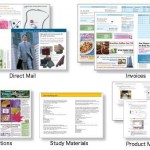Design Tips and Best Practices
‘Eight Edicts’ of Design for Digital Print
Parsons School of Design and Xerox Collaborate on Primer to Facilitate Productive Partnerships between Designers and Digital Printers
 The new generation of designers is learning its craft in a world where everything happens in real time, driving new relationships with technology — and the printing industry.
The new generation of designers is learning its craft in a world where everything happens in real time, driving new relationships with technology — and the printing industry.
Examples can be found in every growth area of the print industry. For example, print-on-demand services require designers and printers to share a commitment to frequent, rapid turnarounds. Personalized, variable information printing can improve response rates when creative teams closely coordinate targeting and production with database managers and print providers. And streamlined work processes can save incredible amounts of time and still deliver high-quality output — provided the designer and printer have the know-how to integrate their digital systems.
10 Tips for Creatives in a Digital World
 In the last 20 years, the creative process has undergone a nearly total digital transformation, giving creatives the power to eliminate steps in the workflow, deliver new value and change the way clients are served. Here are some helpful hints for managing this expanded creative latitude.
In the last 20 years, the creative process has undergone a nearly total digital transformation, giving creatives the power to eliminate steps in the workflow, deliver new value and change the way clients are served. Here are some helpful hints for managing this expanded creative latitude.
- Follow the standards. Standards like SNAP, GRACOL, SWOP, PDF and PDF/X help enable today’s ever-faster turnarounds, ensuring smooth handoffs from creatives to pre-press and printer.
- Simplify the workflow. By moving to a total digital, standards-based workflow, many creative agencies and production operations move at much faster paces, with fewer people.
- Explore elegant digital typography. Much like offset, high-end digital presses are excellent for reproducing solid text with fine lines and serifs as small as four point.